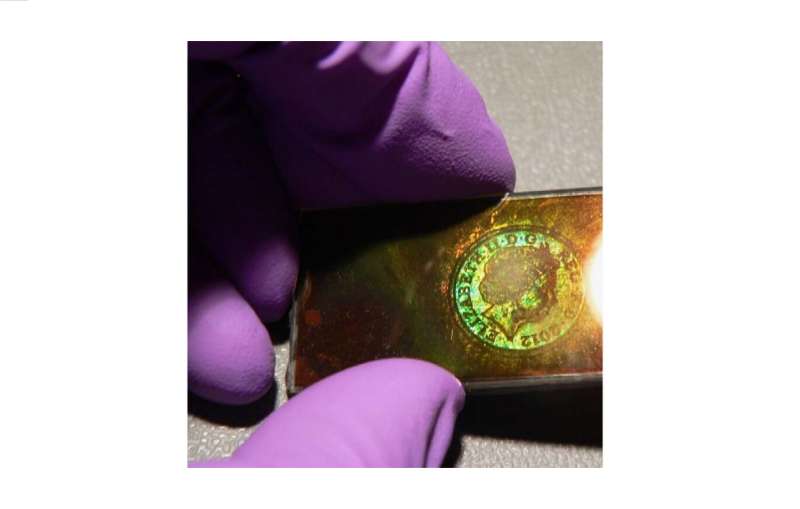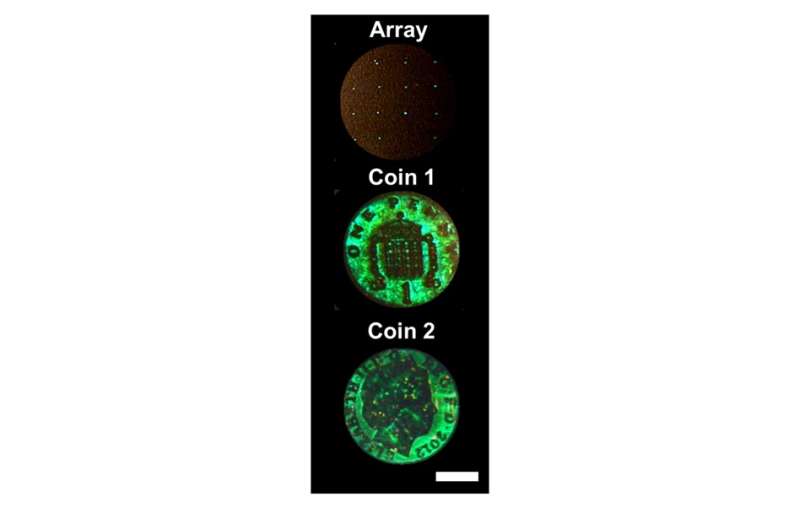September 30, 2016 feature
Optical forces used to make rewritable 3-D holographic materials

(Phys.org)—Researchers have used the pressure of light—also called optical forces or sometimes "tractor beams"—to create a new type of rewritable, dynamic 3D holographic material. Unlike other 3D holographic materials, the new material can be rapidly written and erased many times, and can also store information without using any external energy. The new material has potential applications in 3D holographic displays, large-scale volumetric data storage devices, biosensors, tunable lasers, optical lenses, and metamaterials.
The research was conducted by a multidisciplinary team led by Yunuen Montelongo at Imperial College London and Ali K. Yetisen at Harvard University and MIT. In recent papers published in Nature Communications and Applied Physics Letters, the researchers demonstrated the reversible optical manipulation of nanostructured materials, which they used to fabricate active 3D holograms, lenses, and memory devices.
The key to creating the 3D holographic material with these advantages was to use optical forces to reversibly modify the material's properties. The optical forces are produced by the interference of two or more laser beams, which creates an optical pressure capable of moving nanoscale structures. So far, optical forces have mainly been used for just one application: optical tweezers, which can hold and move tiny objects and are mostly used in biological applications.
In the new study, the researchers have expanded the potential applications of optical forces by demonstrating that they can be applied to reversibly arrange large numbers of silver nanoparticles in well-defined 3D patterns inside a solid material. Information is stored in these patterns, and rearranging them depends on the number, energy, and angle of the laser pulses.
"We demonstrated that optical pressure is capable of assembling nanoparticles inside solids," Montelongo told Phys.org. "Although these types of forces are well-known, this is the first time that they have been used to configure nanostructured materials. This new mechanism is scalable, and therefore, it is possible to assemble large arrays of nanoparticles in a reversible fashion."
Although other methods exist that can manipulate nanoparticles in 3D patterns, most of those methods permanently change the material so that it cannot be rewritten. This is the first time scientists have reversibly controlled 3D arrangements, and have done so without the need for external energy to maintain the recorded information.
The reason why the nanoparticle configurations remain stable without the need for external energy is because the writing process occurs at a high temperature produced by the laser. At the high temperature, the nanostructured material assumes a rubber state, in which it is easily configured, whereas removing the heat effect decreases the temperature and transforms the material into a glass state, in which the configuration is "frozen in."
The researchers describe this phenomenon with the analogy of a "knife in the butter," in which the medium changes its stiffness depending on the metal's temperature: Just as a warm knife slices butter more easily than a cold one, the high temperature allows the optical forces to easily manipulate the nanomaterials in the rubber state.

Overall, the researchers expect that the new method's advantages—including reconfigurability, fast recording, and scalability—make optical forces a promising approach for creating dynamic 3D holograms for a variety of applications.
"Our intention is to develop a new family of photoactive materials that can be applied for rewritable 3D holograms," Montelongo said. "For instance, 3D holograms can be applied in different areas of medicine to replace conventional 2D visualization methods. A hologram can provide a full reconstruction with a sense of volume in the space. These materials are active, and therefore, can be recorded and erased rapidly. In the long term, this mechanism will be used for real-time holographic 3D displays."
More information: Yunuen Montelongo et al. "Reconfigurable optical assembly of nanostructures." Nature Communications. DOI: 10.1038/ncomms12002
Ali K. Yetisen et al. "Rewritable three-dimensional holographic data storage via optical forces." Applied Physics Letters. DOI: 10.1063/1.4960710
Journal information: Nature Communications , Applied Physics Letters
© 2016 Phys.org





















